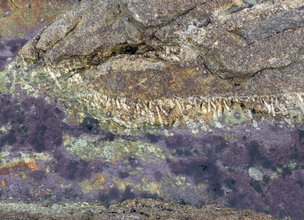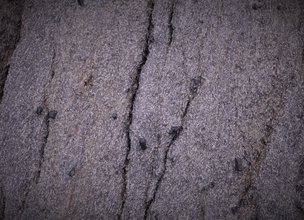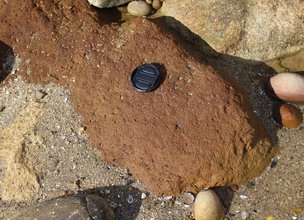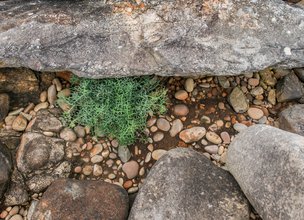Different types of rocks and minerals
In this Local Natural Monument (LNM) there are good conditions for observation and access to address the diversity of geological elements, such as: minerals and granitic rocks, metamorphic rocks, sedimentary rocks and pegmatites.
The Earth’s crust is the outermost layer of the planet with a thickness of 10 to 70 km. It is composed of igneous, metamorphic and sedimentary rocks (Left A).
The rock cycle allows us to understand the interactions between the numerous materials and processes of the Earth system, namely the origin of igneous, sedimentary and metamorphic rocks and the way they relate. The rock cycle shows that any type of rock can be transformed into another type through the action of geological processes.
Diversity of granitic rocks
Granitic rocks are formed when the magma cools down and crystallizes about a dozen kilometers deep. Granite is a common granitic rock.
Granitic rocks may have different minerals because they originate from magmas with different chemical composition. However, quartz and feldspar are minerals always present in granitic rocks; other minerals such as biotite, muscovite, amphibole, garnet, may or may not exist. The cooling rate of magma can be also responsible for granitic rocks with different types of texture. If magma cools down slowly, minerals can grow and the rock might have crystals with several centimeters in length. On the contrary, if magma cools down fast, minerals do not have the chance to grow thus originating a rock with a completely different texture (Fig. 1).
Pegmatites are magmatic rocks with large crystals (> 2,5 cm) which are chemically identical to granitic rocks. They form during the last stages of magma crystallization and sometimes may contain rare chemical elements of economic significance, such as lithium, boron, tantalum, niobium, uranium, and rare earths.
Aplites are magmatic rocks usually light colored with millimetric crystals of quartz and feldspar. Aplites might occur in veins associated with pegmatites because they also form during the final stages of magma crystallization.
Metamorphic rocks
In some places of this LNM, schists with large staurolite and andalusite crystals may be seen in the contact with granitic rocks. Schists are metamorphic rocks and staurolite and andalusite form when the hot granitic magma induce changes in surrounding rocks (Fig. 2).
Sediments and sedimentary rocks
Sediments are fragments of minerals and pre-existing rocks, shells, and other remains of living beings. The compaction of sediments like sand and gravel originates sedimentary rocks, such as sandstones (Fig. 3) and conglomerates (Fig. 4).
References:
Pereira, P; Henriques, R.; Brilha, J. & Pereira, D.I. (2019). Conteúdos científicos para a caracterização dos 8 monumentos naturais locais” enquadrado no projeto Geoparque Litoral de Viana do Castelo – 2ª fase. Município de Viana do Castelo, Relatório Final GEOSITE, 273 p.
In this Local Natural Monument (LNM) there are good conditions for observation and access to address the diversity of geological elements, such as: minerals and granitic rocks, metamorphic rocks, sedimentary rocks and pegmatites.
The Earth’s crust is the outermost layer of the planet with a thickness of 10 to 70 km. It is composed of igneous, metamorphic and sedimentary rocks (Left A).
The rock cycle allows us to understand the interactions between the numerous materials and processes of the Earth system, namely the origin of igneous, sedimentary and metamorphic rocks and the way they relate. The rock cycle shows that any type of rock can be transformed into another type through the action of geological processes.
Diversity of granitic rocks
Granitic rocks are formed when the magma cools down and crystallizes about a dozen kilometers deep. Granite is a common granitic rock.
Granitic rocks may have different minerals because they originate from magmas with different chemical composition. However, quartz and feldspar are minerals always present in granitic rocks; other minerals such as biotite, muscovite, amphibole, garnet, may or may not exist. The cooling rate of magma can be also responsible for granitic rocks with different types of texture. If magma cools down slowly, minerals can grow and the rock might have crystals with several centimeters in length. On the contrary, if magma cools down fast, minerals do not have the chance to grow thus originating a rock with a completely different texture (Fig. 1).
Pegmatites are magmatic rocks with large crystals (> 2,5 cm) which are chemically identical to granitic rocks. They form during the last stages of magma crystallization and sometimes may contain rare chemical elements of economic significance, such as lithium, boron, tantalum, niobium, uranium, and rare earths.
Aplites are magmatic rocks usually light colored with millimetric crystals of quartz and feldspar. Aplites might occur in veins associated with pegmatites because they also form during the final stages of magma crystallization.
Metamorphic rocks
In some places of this LNM, schists with large staurolite and andalusite crystals may be seen in the contact with granitic rocks. Schists are metamorphic rocks and staurolite and andalusite form when the hot granitic magma induce changes in surrounding rocks (Fig. 2).
Sediments and sedimentary rocks
Sediments are fragments of minerals and pre-existing rocks, shells, and other remains of living beings. The compaction of sediments like sand and gravel originates sedimentary rocks, such as sandstones (Fig. 3) and conglomerates (Fig. 4).
References:
Pereira, P; Henriques, R.; Brilha, J. & Pereira, D.I. (2019). Conteúdos científicos para a caracterização dos 8 monumentos naturais locais” enquadrado no projeto Geoparque Litoral de Viana do Castelo – 2ª fase. Município de Viana do Castelo, Relatório Final GEOSITE, 273 p.
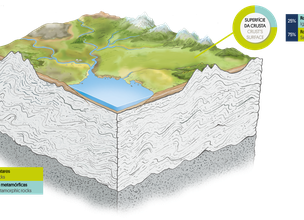
Esq. A - The Earth’s crust is the outermost layer of the planet with a thickness of 10 to 70 km. It is composed of igneous, metamorphic and sedimentary rocks.
Location
Afife
Coordinates
Lat: 41.78936
Long: -8.87112
Hello little one!
I'm Piquinhos and I can help you learn more about the Geopark!
Technical details
Esq. A - The Earth’s crust is the outermost layer of the planet with a thickness of 10 to 70 km. It is composed of igneous, metamorphic and sedimentary rocks.
Child Mode
Discover the geopark in a simpler format, aimed at the little ones.
Clique ENTER para pesquisar ou ESC para sair
